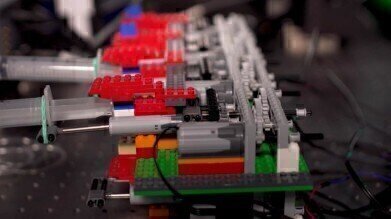-
 NanoJ-Fluidics device built with LEGO. (Credit: Ricardo Henriques)
NanoJ-Fluidics device built with LEGO. (Credit: Ricardo Henriques)
News
Low Tech Build Supports Cutting Edge Microscopy
Mar 26 2019
Researchers have come up with an inexpensive, automated way to image biological samples, using the children’s toy, LEGO.
Scientists at the Crick, UCL and Aix University in Marseille have described* a novel inexpensive device, built with LEGO parts, that can be adapted to most microscopes.
“Sometimes the best solutions to complex biological questions are remarkably low-tech,” says Ricardo Henriques, who runs a satellite lab at the Crick and led the project.
“By developing hardware that uses inexpensive LEGO components as its building blocks, we’ve built an accessible tool that delivers customisable cutting-edge microscopy at a fraction of the cost.”
The device, called NanoJ-Fluidics (and nicknamed Pumpy McPumpface), enables researchers to observe cells in a highly customisable format. For the very first time, researchers can observe samples of cells at well-defined moments in time, for example when they are dividing or become sick. After this initial round of observation, the LEGO device can manipulate the liquid environment of the cells in a completely automated manner, enabling subsequent imaging of the same cells at a much higher nanoscale resolution.
The LEGO hardware and accompanying software are fully open-source, enabling other researcher groups to make their own devices. Thanks to this open science approach, NanoJ-Fluidics has already been successfully adopted by over 10 labs across the world.
*Published in Nature Communications
Digital Edition
Lab Asia Dec 2025
December 2025
Chromatography Articles- Cutting-edge sample preparation tools help laboratories to stay ahead of the curveMass Spectrometry & Spectroscopy Articles- Unlocking the complexity of metabolomics: Pushi...
View all digital editions
Events
Jan 21 2026 Tokyo, Japan
Jan 28 2026 Tokyo, Japan
Jan 29 2026 New Delhi, India
Feb 07 2026 Boston, MA, USA
Asia Pharma Expo/Asia Lab Expo
Feb 12 2026 Dhaka, Bangladesh


















